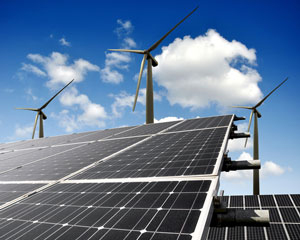Wind-solar hybrid projects are displaying vast potential for commercial applications internationally.
Solar and wind generation make for a powerful match than what has been initially perceived of it. A wind-solar hybrid system is advantageous because it includes the utilisation of both wind and solar power as renewable energy sources. Quite obviously, solar panels are not able to provide sufficient power at night, a time when, interestingly enough, the winds usually pick up.
On the other hand, the wind does not blow often during the summer, albeit sunlight is stronger and longer, an excellent condition for using and storing solar power. Winds are more prevalent during the short, cold winter days when, conversely, the sun’s strength is almost powerless. How can different kinds of electric current and condition be converted into one stable and reliable source of power for a home or building?
How Wind-Solar Hybrid Works
A wind-solar hybrid system may have separate solar arrays and wind turbines held together by a controller. Some companies have incorporated both into a single installation to make the system’s complexity simpler and reduce the overall footprint it generates. The addition of a second or third power supplier to any technology will also increase the cost it needs to be operable.
Fortunately, this hybrid system has specialised electric controllers designed to easily integrate a solar panel array’s Direct Current (DC) power, the power obtained from a back-up unit, and the wind turbines’s three-phase Alternating Current (AC) or AC/DC. The controllers integrate the wind, back-up unit, and solar energy to provide power to the consumer, the grid or a battery bank.
Hybrid systems do not have bargain prices, however, and when a home’s location is more than a kilometre off a grid, it can become expensive to run power lines to the residence and eclipse whatever costs there were for the installation of the hybrid system, a back-up unit, and a generator or battery bank.
The Solar Mill
Engineers at WindStream Technologies, based in Indiana in the U.S, have designed what has been termed the most complete device for generation of renewable energy: the solar mill. Made of quality solar photovoltaic (PV) panels, a set of wind turbines with vertical axis, and an integrated, patented electronics system, this device has the highest density of energy in today’s market.
How a Solar Mill Works
The solar mill is driven by DC power, meaning, its electricity flow is unidirectional. And that being the case, energy derived from sunlight can be directly used to charge the mill without the need to transform electricity with the use of a generator. The solar power system used for a mill consists of a charge controller, batteries, and PV panels.
The solar mill system is suitable for use in decentralised applications, meaning they may be used in any geographical location where solar radiation’s availability is sufficient. The downside, archetypical of PV technologies, is its high start-up cost, not to mention that those in lower socio-economic brackets will find its price rather prohibitive without adequate financing.
Between them, wind and solar generation offer a better alternative to grid-charge electricity. Hybrid power does not need grid expansion since there is already wind and solar power generation during various times of the day as well as during the different seasons.
Because if this, there is an assurance that energy levels are sent to the grid more steadily than those of PV or wind power systems alone. When neither of these are operational, tying the wind-solar hybrid system to the grid with the use of a battery bank’s stored energy or utilising a back-up generator unit is the solution.
